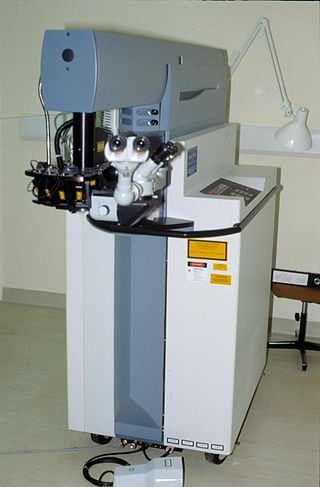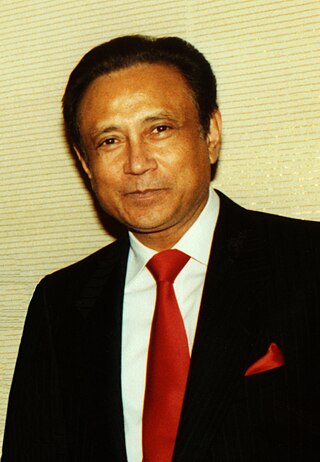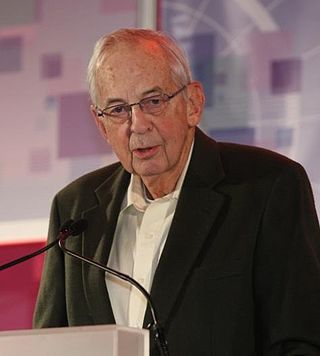Related Research Articles

A laser is a device that emits light through a process of optical amplification based on the stimulated emission of electromagnetic radiation. The word laser is an anacronym that originated as an acronym for light amplification by stimulated emission of radiation. The first laser was built in 1960 by Theodore Maiman at Hughes Research Laboratories, based on theoretical work by Charles H. Townes and Arthur Leonard Schawlow.

LASIK or Lasik, commonly referred to as laser eye surgery or laser vision correction, is a type of refractive surgery for the correction of myopia, hyperopia, and an actual cure for astigmatism, since it is in the cornea. LASIK surgery is performed by an ophthalmologist who uses a laser or microkeratome to reshape the eye's cornea in order to improve visual acuity. For most people, LASIK provides a long-lasting alternative to eyeglasses or contact lenses.

An excimer laser, sometimes more correctly called an exciplex laser, is a form of ultraviolet laser which is commonly used in the production of microelectronic devices, semiconductor based integrated circuits or "chips", eye surgery, and micromachining. Since 1960s excimer lasers are widely used in high-resolution photolithography machines, one of the critical technologies required for microelectronic chip manufacturing.

Refractive eye surgery is optional eye surgery used to improve the refractive state of the eye and decrease or eliminate dependency on glasses or contact lenses. This can include various methods of surgical remodeling of the cornea (keratomileusis), lens implantation or lens replacement. The most common methods today use excimer lasers to reshape the curvature of the cornea. Refractive eye surgeries are used to treat common vision disorders such as myopia, hyperopia, presbyopia and astigmatism.

Gérard Albert Mourou is a French scientist and pioneer in the field of electrical engineering and lasers. He was awarded a Nobel Prize in Physics in 2018, along with Donna Strickland, for the invention of chirped pulse amplification, a technique later used to create ultrashort-pulse, very high-intensity (petawatt) laser pulses.

A krypton fluoride laser is a particular type of excimer laser, which is sometimes called an exciplex laser. With its 248 nanometer wavelength, it is a deep ultraviolet laser which is commonly used in the production of semiconductor integrated circuits, industrial micromachining, and scientific research. The term excimer is short for 'excited dimer', while exciplex is short for 'excited complex'. An excimer laser typically contains a mixture of: a noble gas such as argon, krypton, or xenon; and a halogen gas such as fluorine or chlorine. Under suitably intense conditions of electromagnetic stimulation and pressure, the mixture emits a beam of coherent stimulated radiation as laser light in the ultraviolet range.

Mani Lal Bhaumik is an Indian American physicist and a bestselling author.
Rangaswamy Srinivasan is a physical chemist and inventor with a 30-year career at IBM Research. He has developed techniques for ablative photodecomposition and used them to contribute to the development of LASIK eye surgery.
Samuel E. Blum was an American chemist and physicist. He was a researcher at the Battelle Memorial Institute in Columbus, Ohio, working for government and private companies. He worked with semiconductor materials, which was his specialization until his retirement from IBM Watson Research Center in 1990.

Robert Louis Byer is a physicist. He was president of the Optical Society of America in 1994 and of the American Physical Society in 2012.
Anthony Michael Johnson is an American experimental physicist, a professor of physics, and a professor of computer science and electrical engineering at the University of Maryland, Baltimore County (UMBC). He is the Director of the Center for Advanced Studies in Photonics Research (CASPR), also situated on campus at UMBC. Since his election to the 2002 term as president of the Optical Society, formerly the Optical Society of America, Johnson has the distinction of being the first and only African-American president to date. Johnson's research interests include the ultrafast photophysics and nonlinear optical properties of bulk, nanostructured, and quantum well semiconductor structures, ultrashort pulse propagation in fibers and high-speed lightwave systems. His research has helped to better understand processes that occur in ultrafast time frames of 1 quadrillionth of a second. Ultrashort pulses of light have been used to address technical and logistical challenges in medicine, telecommunications, homeland security, and have many other applications that enhance contemporary life.
Erich P. Ippen is a principal investigator in the Research Laboratory of Electronics (RLE) at the Massachusetts Institute of Technology (MIT). He holds appointments as the Elihu Thomson Professor of Electrical Engineering Emeritus and Professor of Physics Emeritus. He is one of the leaders of RLE’s Optics and Quantum Electronics Group.
The argon fluoride laser is a particular type of excimer laser, which is sometimes called an exciplex laser. With its 193-nanometer wavelength, it is a deep ultraviolet laser, which is commonly used in the production of semiconductor integrated circuits, eye surgery, micromachining, and scientific research. "Excimer" is short for "excited dimer", while "exciplex" is short for "excited complex". An excimer laser typically uses a mixture of a noble gas and a halogen gas, which under suitable conditions of electrical stimulation and high pressure, emits coherent stimulated radiation in the ultraviolet range.

James Power Gordon was an American physicist known for his work in the fields of optics and quantum electronics. His contributions include the design, analysis and construction of the first maser in 1954 as a doctoral student at Columbia University under the supervision of C. H. Townes, development of the quantal equivalent of Shannon's information capacity formula in 1962, development of the theory for the diffusion of atoms in an optical trap in 1980, and the discovery of what is now known as the Gordon-Haus effect in soliton transmission, together with H. A. Haus in 1986. Gordon was a member of the National Academy of Engineering and the National Academy of Sciences.
Peter S. Hersh is an American ophthalmologist and specialist in LASIK eye surgery, keratoconus, and diseases of the cornea. He co-authored the article in the journal Ophthalmology that presented the results of the study that led to the first approval by the U.S. Food and Drug Administration (FDA) of the excimer laser for the correction of nearsightedness in the United States. Hersh was also medical monitor of the study that led to approval of corneal collagen crosslinking for the treatment of keratoconus.
Richard Magee Osgood Junior. is an American applied and pure physicist. He is currently Higgins Professor of Electrical Engineering and Applied Physics at Columbia University.

Donna Theo Strickland is a Canadian optical physicist and pioneer in the field of pulsed lasers. She was awarded the Nobel Prize in Physics in 2018, together with Gérard Mourou, for the practical implementation of chirped pulse amplification. She is a professor at the University of Waterloo in Ontario, Canada.
Chen Chuangtian, also known as Chuang-Tian Chen, was a Chinese materials scientist and physical chemist who specialized in crystals used in lasers. He discovered the nonlinear optical crystals BBO, LBO and KBBF, which have important uses in areas including superconductor research, semiconductor photolithography, and the medical industry. He was an academician of the Chinese Academy of Sciences and a fellow of The World Academy of Sciences. He was awarded the TWAS Prize in Chemistry, the State Technological Invention Award, and the Laudise Prize.

Debabrata Goswami FInstP FRSC, is an Indian chemist and the Prof. S. Sampath Chair Professor of Chemistry, at the Indian Institute of Technology Kanpur. He is also a professor of The Department of Chemistry and The Center for Lasers & Photonics at the same Institute. Goswami is an associate editor of the open-access journal Science Advances. He is also an Academic Editor for PLOS One and PeerJ Chemistry. He has contributed to the theory of Quantum Computing as well as nonlinear optical spectroscopy. His work is documented in more than 200 research publications. He is an elected Fellow of the Royal Society of Chemistry, Fellow of the Institute of Physics, the SPIE, and The Optical Society. He is also a Senior Member of the IEEE, has been awarded a Swarnajayanti Fellowship for Chemical Sciences, and has held a Wellcome Trust Senior Research Fellowship. He is the third Indian to be awarded the International Commission for Optics Galileo Galilei Medal for excellence in optics.
János Hebling is a Hungarian physicist, known for his preliminary works at Terahertz physics and spectroscopy. He was born at Zirc on 9 May 1954 and currently works as a professor at the Institute of Physics at University of Pécs and is an active researcher at the Hungarian Academy of Sciences and ELI.
References
- ↑ "2013 Russ Prize". Ohio University. February 18, 2013. Retrieved November 23, 2022.
- ↑ Life-history for American Men and Women of Science, Thomson Gale 2004
- ↑ Lyndsay Meyer, "How a Leftover Thanksgiving Dinner Gave Us LASIK Surgery", Optical Society of America, November 25, 2013,
- ↑ Randall Lane, Ralph Linsker, James Wynne, Torres, Geronemus' Ultraviolet Laser Ablation of Skin , Archives of Dermatology 121, 609–617 (1985)
- ↑ Lane, Wynne, Geronemus, Ultraviolet Laser Ablation of Skin: Healing Studies and a Thermal Model , Lasers in Surgery and Medicine 6, 504 -513 (1987)
- ↑ ArF excimer laser debrides burns without destruction of viable tissue: A pilot study https://pubmed.ncbi.nlm.nih.gov/29456098/